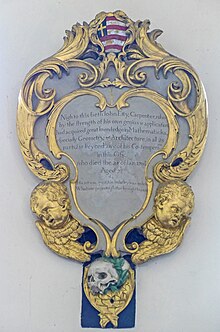
Sir Joshua Reynolds was an English painter who specialised in portraits. The art critic John Russell called him one of the major European painters of the 18th century, while Lucy Peltz says he was "the leading portrait artist of the 18th-century and arguably one of the greatest artists in the history of art." He promoted the "Grand Style" in painting, which depended on idealisation of the imperfect. He was a founder and first president of the Royal Academy of Arts and was knighted by George III in 1769.
This article contains information about the literary events and publications of 1753.

Benjamin West was a British-American artist who painted famous historical scenes such as The Death of Nelson, The Death of General Wolfe, the Treaty of Paris, and Benjamin Franklin Drawing Electricity from the Sky.

William Etty was an English artist best known for his history paintings containing nude figures. He was the first significant British painter of nudes and still lifes. Born in York, he left school at the age of 12 to become an apprentice printer in Hull. He completed his apprenticeship seven years later and moved to London, where in 1807 he joined the Royal Academy Schools. There he studied under Thomas Lawrence and trained by copying works by other artists. Etty earned respect at the Royal Academy of Arts for his ability to paint realistic flesh tones, but had little commercial or critical success in his first few years in London.

John Smibert was a Scottish-born painter who was the first academically trained artist to work in British America.
Events in the year 1821 in Art.
Events from the year 1787 in art.

Thomas Bray was an English clergyman and abolitionist who helped formally establish the Church of England in Maryland, as well as the Society for the Propagation of Christian Knowledge and Society for the Propagation of the Gospel in Foreign Parts.
Martin Postle is a British art historian who is deputy director for collections and publications at the Paul Mellon Centre for Studies in British Art, London, and a leading expert on the art of Sir Joshua Reynolds. He is a former curator at the Tate Gallery.
William Camidge F.R.H.S. (1828–1909) was a British solicitor and author based in York. He wrote histories of Methodism and a biography of the painter William Etty. He was a Royal Historical Society, and a Primitive Methodist associated with Elmfield College.
Henry Gyles or Giles (1640?-1709), was an English glass painter based in York.
Richard Evans (1784–1871), was an English portrait-painter and copyist, a pupil and later assistant of Sir Thomas Lawrence.
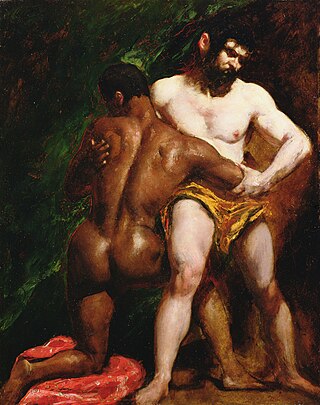
The Wrestlers is an oil painting on millboard by English artist William Etty, painted around 1840 and currently in the York Art Gallery, in York, England. It depicts a wrestling match between a black man and a white man, both glistening with sweat and under an intense light emphasising their curves and musculature. While little documentation of the painting exists prior to 1947, it is likely that it was painted over a period of three evenings at the life class of the Royal Academy.

Preparing for a Fancy Dress Ball, also known as The Misses Williams-Wynn, is a 173 by 150 cm oil on canvas by English artist William Etty, first exhibited in 1835 and currently in the York Art Gallery. Although Etty was then known almost exclusively for history paintings featuring nude figures, he was commissioned in 1833 by Welsh Conservative politician Charles Watkin Williams-Wynn to paint a portrait of two of his daughters. Preparing for a Fancy Dress Ball shows Williams-Wynn's daughters, Charlotte and Mary, in lavish Italian-style costume: Charlotte, the eldest, is shown standing, helping the seated Mary decorate her hair with a ribbon and a rose. Etty put a good deal of effort into the piece and took much longer than usual to finish it.

Musidora: The Bather 'At the Doubtful Breeze Alarmed', also known as The Bather, is a name given to four nearly identical oil paintings on canvas by English artist William Etty. The paintings illustrate a scene from James Thomson's 1727 poem Summer in which a young man accidentally sees a young woman bathing naked and is torn between his desire to look and his knowledge that he ought to look away. The scene was popular with English artists as it was one of the few legitimate pretexts to paint nudes at a time when the display and distribution of nude imagery was suppressed.
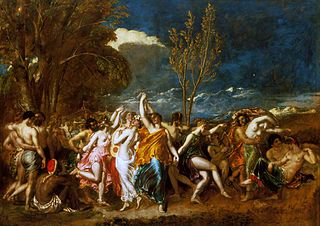
The World Before the Flood is an oil-on-canvas painting by the English artist William Etty, first exhibited in 1828 and currently in the Southampton City Art Gallery. It depicts a scene from John Milton's Paradise Lost in which, among a series of visions of the future shown to Adam, he sees the world immediately before the Great Flood. The painting illustrates the stages of courtship as described by Milton: a group of men select wives from a group of dancing women, drag their chosen woman from the group, and settle down to married life. Behind the courting group, an oncoming storm looms, foreshadowing the destruction which the dancers and lovers are about to bring upon themselves.
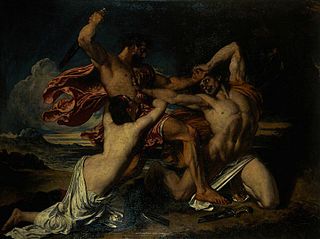
The Combat: Woman Pleading for the Vanquished is a large oil painting on canvas by English artist William Etty, first exhibited in 1825 and now in the National Gallery of Scotland. Inspired by the Elgin Marbles and intended by the artist to provide a moral lesson on "the beauty of mercy", it shows a near-nude warrior whose sword has broken, forced to his knees in front of another near-nude soldier who prepares to inflict a killing blow. A woman, also near-nude, clutches the victorious warrior to beg him for mercy. Unusually for a history painting of the period, The Combat does not depict a scene from history, literature or religion and is not based on an existing artwork, but is instead a scene from the artist's own imagination.

The Triumph of Cleopatra, also known as Cleopatra's Arrival in Cilicia and The Arrival of Cleopatra in Cilicia, is an oil painting by English artist William Etty. It was first exhibited in 1821, and is now in the Lady Lever Art Gallery in Port Sunlight, Merseyside. During the 1810s Etty had become widely respected among staff and students at the Royal Academy of Arts, in particular for his use of colour and ability to paint realistic flesh tones. Despite having exhibited at every Summer Exhibition since 1811, he attracted little commercial or critical interest. In 1820, he exhibited The Coral Finder, which showed nude figures on a gilded boat. This painting attracted the attention of Sir Francis Freeling, who commissioned a similar painting on a more ambitious scale.

Britomart Redeems Faire Amoret is an oil painting on canvas by English artist William Etty, first exhibited in 1833 and now in Tate Britain. Intended to illustrate the virtues of honour and chastity, it depicts a scene from Edmund Spenser's The Faerie Queene in which the female warrior Britomart slays the evil magician Busirane and frees his captive, the beautiful Amoret. In Spenser's original poem Amoret has been tortured and mutilated by the time of her rescue, but Etty disliked the depiction of violence and portrayed her as unharmed.
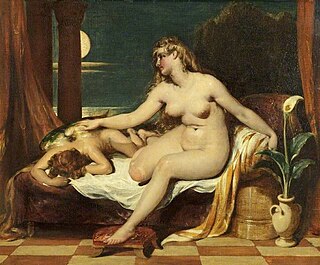
The Dawn of Love, also known as Venus Now Wakes, and Wakens Love, is an oil painting on canvas by English artist William Etty, first exhibited in 1828 and currently in the Russell-Cotes Art Gallery & Museum in Bournemouth. Loosely based on a passage from John Milton's 1634 masque Comus, it shows a nude Venus leaning across to wake the sleeping Love by stroking his wings. While Etty often included nude figures in his work, he rarely depicted physical intimacy, and owing to this, The Dawn of Love is one of his more unusual paintings. The open sensuality of the work was intended to present a challenge to the viewer mirroring the plot of Comus, in which the heroine is tempted by desire but remains rational and detached.
